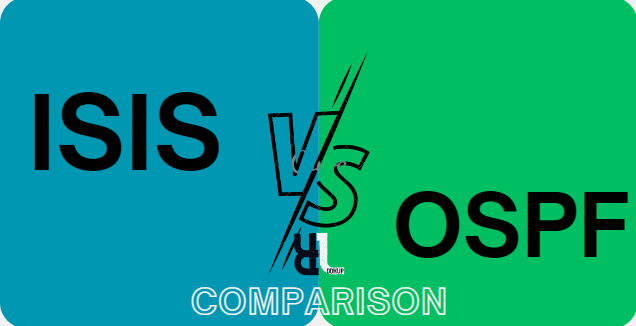Welcome to the updated version of our comparison between ISIS and OSPF. Since our original article was published in 2013, both protocols have undergone significant changes, making it important to revisit their differences and similarities. In this article, we will provide you with the most recent updates on ISIS and OSPF, and include a comparison table to help you understand the key features of each protocol. So, let’s dive in!
Factors to Consider When Choosing a Routing Protocol
Selecting the appropriate routing protocol for your network is a complex decision that demands careful consideration. The selected protocol will significantly impact the network’s performance and efficiency, making it crucial to assess your network’s requirements such as the size, type of applications and services, hardware and software resources, and desired level of resilience and redundancy. It’s also crucial to consider the scalability, stability, and security features of the protocol to support your network’s current and future needs. Additionally, evaluating compatibility with your equipment and availability of technical support can help in making an informed decision. By carefully considering these factors, you can select a routing protocol that ensures optimal network performance, resilience, and availability.
In service provider networks, the choice of routing protocols is typically limited. However, there is often a tough decision to be made between two of the most popular protocols, ISIS and OSPF. These protocols are both widely used and have their respective advantages and disadvantages, which can make it challenging to choose between them. Service providers need to carefully evaluate the specific needs of their network and weigh the benefits and drawbacks of each protocol to make the right choice.
Battle Between ISIS and OSPF
Both ISIS and OSPF were developed early in the history of networking, at a time when there was a battle between IP and ISO to be the standard of the internet. Ultimately, IP was adopted as the standard, and OSPF was chosen as the routing protocol over ISIS, which relied on ISO addressing and standards. However, in the years that followed, ISIS was developed to be integrated with the IP suite, giving it a chance to enter a new battle against OSPF. [rml_read_more]
Choosing Between ISIS and OSPF in Service Provider Networks
At the old days, we had no choice and implementing OSPF in all SP networks, but NOW we have also ISIS and many scouts are wondering which protocol is better to implement and what are the differences?
Yes, good question “What are the differences between ISIS & OSPF” that really would help in choosing an IGP for your SP network.
Understanding the Differences Between ISIS and OSPF:
A Comparison Table
Here is a table that outlines the similarities and differences between ISIS and OSPF:
| Feature | IS-IS | OSPF |
|---|---|---|
| Protocol Type | Link-State | Link-State |
| Standard | ISO/IEC 10589 | IETF RFC 2328 (OSPFv2), RFC 5340 (OSPFv3) |
| Addressing | Uses NSAP addresses | Uses IP addresses (IPv4/IPv6) |
| Hierarchical Structure | Two-Level Hierarchy (Level-1/Level-2) | Two-Level Hierarchy (Areas) |
| Area Border Router Type | Level-1/Level-2 Router | Area Border Router (ABR) |
| Flooding Domain | Level-1: Within an area, Level-2: Between areas | Within an area |
| Topology Filtering | Supported via route leaking | Supported via filtering LSAs |
| Protocol Extensibility | Flexible TLV structure | Fixed LSA structure |
| Flooding Scope | Link-State PDUs (LSPs) | Link-State Advertisements (LSAs) |
| Metrics | Default metric: Link cost | Default metric: Cost |
| Multi-Topology Support | Built-in (Multi-topology IS-IS) | Requires OSPFv3 extensions |
| Authentication | Clear-text or MD5 | Clear-text, MD5, or SHA |
| IPv6 Support | Integrated (with extensions) | Separate protocol (OSPFv3) |
| Admin Distance | 115 (default) | 110 (default) |
| Segment Routing Support | Yes (with extensions) | Yes (with OSPF-SR extensions) |
Understanding the differences in hierarchy and flooding domains
In OSPF, there are two levels of hierarchy: a central area (backbone area 0) and peripheral areas. Area 0 operates independently and centralizes all routing information, while peripheral areas must be connected to Area 0 to receive routes from other areas. OSPF routers can be connected to multiple areas, and these devices are designated as ABRs.
In IS-IS, there are also two levels of hierarchy: Level 1 (L1) and Level 2 (L2). An IS-IS router can be connected to multiple domains, and these devices are designated as L1L2 routers. The L2 domain in IS-IS is equivalent to the OSPF backbone area (0), and it centralizes all routing information. The L1 domain is equivalent to a Totally NSSA in OSPF, and it only accepts the default route from an L1L2 router. L1L2 routers also allow specific L2 routes to be redistributed within the L1 domain (route leaking). An IS-IS router can only belong to one domain (unlike OSPF).
The flooding domain in OSPF is achieved by area, and each area has its own topology information with its own LSAs (type 1 and 2) that are never exchanged with other areas. The reachability information is transmitted between areas (LSA type 3). An OSPF router connected to multiple areas (ABR) will have multiple topology and reachability entries associated with each area, which increases the size of the LSDB. Routers belonging to the same area are synchronized to have the same copy of the topology, and only one LSDB is constructed per OSPF process.
The flooding domain in IS-IS is achieved by Level (L1 and L2), and two separate LSDBs are built for each domain. A L1L2 IS-IS router has two LSDBs and also allows the exchange of reachability information between L1 and L2 domains. IS-IS routers of type L1 or L2 have only one LSDB associated with the domain. The concept of an area in IS-IS does not define the flooding domain, it simply provides organization in the network.
Support for IPv6, MPLS, and TE
For the calculation of the best path, both protocols (IS-IS and OSPF) require that routers belonging to the same area or level (L1 or L2) have the same topological view, otherwise loops could occur on the network. For both protocols, it is not possible to do filtering within the area or level (L1 or L2). The filtering of LSA in OSPF is possible between areas and is done on ABRs. In OSPF, filtering is also possible with external protocols, and it is done on ASBRs. In IS-IS, filtering is possible between the two levels (L1 and L2), and it is done on L1L2 routers. Another difference is in the support of Traffic Engineering (TE) and Multiprotocol Label Switching (MPLS). IS-IS supports TE and MPLS from the beginning and uses TLV 22 for MPLS, whereas OSPF added support for MPLS later and uses TLV 1 for OSPFv2 and TLV 2 for OSPFv3. Additionally, both protocols have support for IPv6, but IS-IS has been supporting it from the beginning, while OSPF added support for IPv6 later and requires different commands to enable it on a per-interface basis. Finally, the protocols have different multicast addresses used for routing updates, with IS-IS using 01:00:5e:00:00:14 for all Level 1 routers, 01:00:5e:00:00:15 for all Level 2 routers, and 01:00:5e:00:02:XX for the designated router of each level, while OSPF uses 224.0.0.5 for all OSPF routers and 224.0.0.6 for all designated routers.
How they handle designated routers and designated intermediate systems
Both OSPF and ISIS use a designated router (DR) to reduce the amount of flooding and the size of the link-state database. In OSPF, the DR is elected on a per-broadcast network segment (i.e., Ethernet, Token Ring) and is responsible for forwarding and receiving OSPF messages on behalf of non-DR routers.
In contrast, ISIS elects a designated intermediate system (DIS) for each broadcast or point-to-point network segment. The DIS performs a similar role as the OSPF DR in terms of reducing flooding and database size, but it also plays a crucial role in the formation of the ISIS hierarchy by acting as the central point of control for its attached routers.
The DR and DIS election processes differ in the way they handle the election and removal of the designated router. The DR election in OSPF is based on the priority value assigned to each router, while the DIS election in ISIS is based on the priority value as well as the system ID.
More details about the DIS election process in ISIS can be found in my other article “Designated router in ISIS.”
Osama Aboelfath

Osama Aboelfath is co-founder at Recursive-lookup. Osama is a network engineer and developer with over 10 years of production network engineering, deployment & operation.





